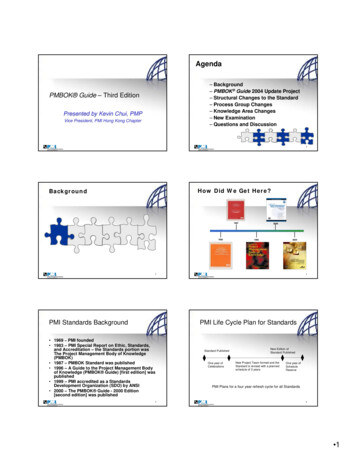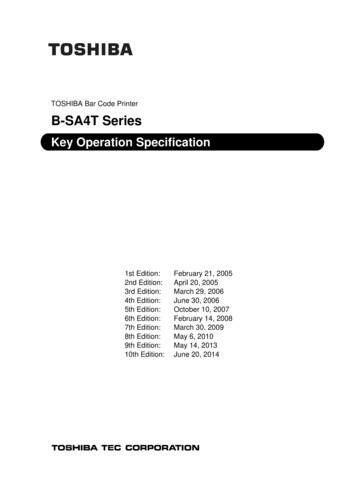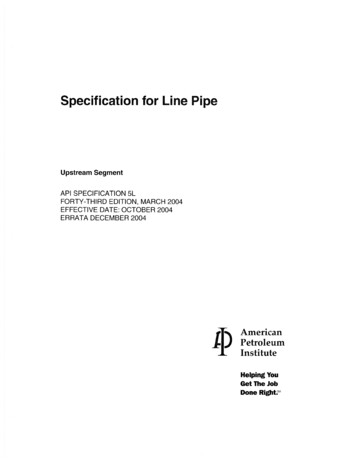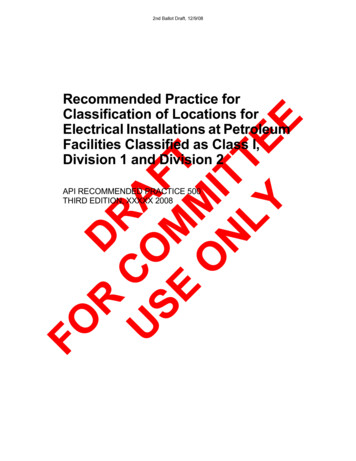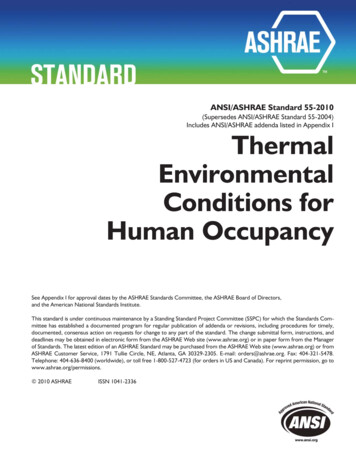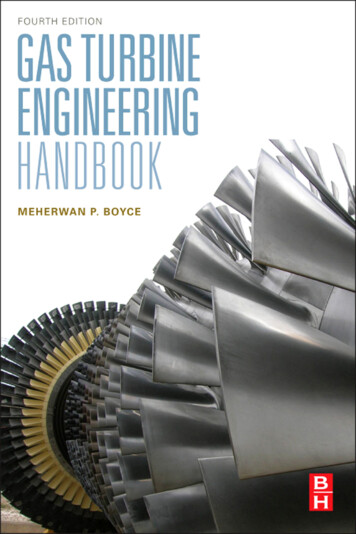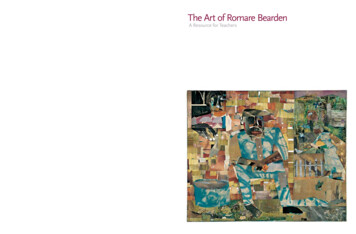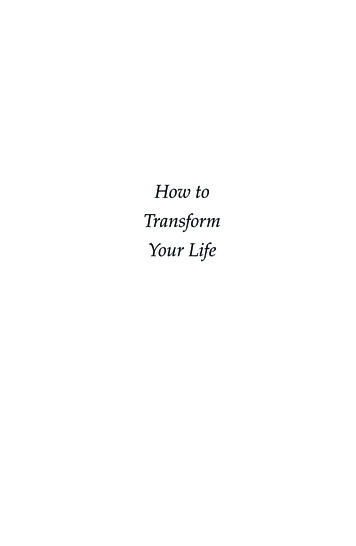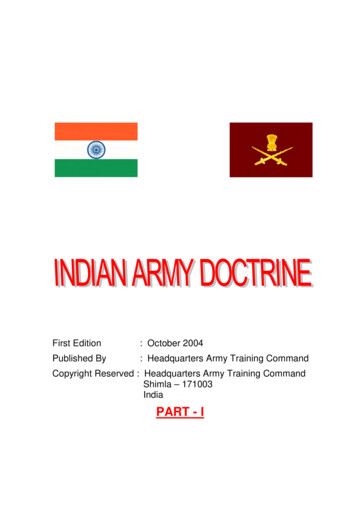
Transcription
First Edition: October 2004Published By: Headquarters Army Training CommandCopyright Reserved : Headquarters Army Training CommandShimla – 171003IndiaPART - I
PROMULGATION1.The Indian Army Doctrine is structured as a two-partdocument. The main part contains subjects for widespreaddissemination in the Army, the second part is the classifiedadjunct to it and is intended for very restricted circulation.2.Having been approved by Army Headquarters, the mainpart of the Indian Army Doctrine is hereby promulgated forinformation, guidance and implementation by all concerned.3.Part I will be reviewed every five years and updated, asnecessary. The Doctrine will be re-issued every ten years.ShimlaOctober 2004(K Nagaraj)Lt GenGOC-in-C ARTRAC
CODE OF THE WARRIOR“I am a Warrior; defending my Nation is my dharma.I will train my mind, body and spirit to fight,Excel in all devices and weapons of war –present and future,Always protect the weak,Be truthful and forthright,Be humane, cultured and compassionate,Fight and embrace the consequences willingly.God, give me strength that I ask nothing of you”– The Bhagawad Gita
General NC VijPVSM, UYSM, AVSM, ADCFOREWORD“How can man die better, than facing fearful odds,for the ashes of his fathers and the temples of his Gods.”Like all other modern armed forces, the Indian Army hasbeen considerably influenced by the Revolution in MilitaryAffairs and the great strides being made in technologydevelopment. This has necessitated a transformation instrategic thinking along with a paradigm shift in organizationand conduct of operations. As a consequence, militarydoctrines, weapon systems and force structures need toundergo a review. Our vision for the twenty-first century is tohave a well equipped and optimally structured army, enablingit to respond effectively to varied situations and demandswhilst it continually adapts itself to meet future challenges.Such a vision places emphasis on the ability to augmentexisting strengths, develop new skills, think imaginatively andattempt innovative approaches to cope with the emergingenvironment. The challenges that we will be confronted withrequire us to visualize what our Army of the future should looklike and accordingly develop suitable approaches to structures,equipping and training to emerge with flying colours in futureconflict situations. The impetus for change must come fromwithin and flow through the entire Army.
(ii)The Indian Army has to maintain a high level of readinessfor war in varied terrain conditions and should have thecapability to operate in the complete spectrum of conflict. TheIndian Army Doctrine (hereinafter referred to as the ‘Doctrine’)outlines a framework for a better understanding of theapproach to warfare and provides the foundation for itspractical application.Funds scarcity or shortfall is a challenge faced by allarmies of the world and hence there is a need for improvedoperating cultures and optimization of resources. The winningarmies of the future will not necessarily be the ones that havegreater combat power but ones that can visualize andcomprehend battles more clearly. There will invariably betechnological gaps between the systems that we possess andthose developed up to that point in time. Notwithstanding thisgap we have to continuously utilize all available resourcesimaginatively and effectively.The emergence of Information Warfare as a major forcemultiplier points clearly towards the imperatives of networkcentric warfare. Additionally, present trends indicate a markedshift towards the manoeuvre style of warfare and directivestyle of command. Concurrently, the requirement for jointoperations and the need for greater integration and interdependence amongst the three Services are viewed as beingessential for success.This Doctrine emphasizes that the profession of arms is acalling. The hallmark of a good soldier entails having a senseof responsibility, professional expertise and loyalty to theNation and the Army. The ethos and moral code set forthprinciples and ideals; these exhort every man in uniform toabide by his duty without regard to personal safety. This ethosforms the bedrock of the Army’s preparedness in peace and isthe key to its effectiveness in war.Indian Army officers would do well to develop a broadbased, all-inclusive understanding of warfare and not become
(iii)overly reliant on rigid adherence to prescriptive rules. Thenature of this Doctrine is enduring and yet dynamic; it drivesdevelopment of both, the art and science of war. In the Army itprovides the focus for constructive debate within well-informedand professional circles and acts as a guide to the youngergeneration. Training in the Army should focus on managementof change and operational adaptation to change. Towards thisend, providing the kind of ambience that encourages andfacilitates intellectual development should be an unceasingendeavour.(NC Vij)October 2004General“Not by action Not by progenyNot by wealth But by sacrifice aloneCan Immortal Goal be achieved.”– The Bhagawad Gita
“And speak not of those who areslain in Allah’s way as dead,Nay, (they are) alive but ye perceive not”.–Sureh Bacarah, Ayat 154,The Holy Quran
TABLE OF CONTENTSChapter 1- Geo-Strategic Environment andThe Indian ArmySection 1 : Doctrine, Concept and StrategySection 2 : Environment and ThreatSection 3 : The Indian Army2359Chapter 2 - Understanding War11Section 4 : Peace, Conflict and WarSection 5 : Types of WarsSection 6 : Principles of War121523Chapter 3 - Operational Perspectives25Section 7Section 8Section 9Section 1026343840::::Elements for Operational SuccessOperational Readiness and EffectivenessSurprise and DeceptionImpact of Technology on Operations andthe Revolution in Military AffairsChapter 4 - Conduct of Operations46Section 11 : Offensive and Defensive OperationsSection 12 : Special Forces OperationsSection 13 : Joint Operations475760Chapter 5 - Operations Other Than War67Section 14 : Low Intensity Conflict Operations andCounter-Insurgency OperationsSection 15 : Non-Combat OperationsSection 16 : United Nations Peacekeeping Missions687781Chapter 6 - Logistics84Section 17 : Function, Principles and LogisticSupport SystemsSection 18 : Future Trends in Logistics8589Chapter 7 - Preparing For War92Section 19 : Force StructuringSection 20 : TrainingSection 21 : Professionalism and Military Ethos9397103
2CHAPTER 1GEO-STRATEGIC ENVIRONMENT ANDTHE INDIAN ARMYSECTION 1 : DOCTRINE, CONCEPT AND STRATEGYSECTION 2 : ENVIRONMENT AND THREATSECTION 3 : THE INDIAN ARMY
3SECTION 1 : DOCTRINE, CONCEPT ANDSTRATEGY“Doctrine is indispensable to an army. Doctrineprovides a military organisation with a commonphilosophy, a common language, a common purpose,and a unity of effort”.– General George H. Decker, 1960.Doctrine1.1Military doctrines have provided the basic approach toall important aspects related to war for armies of most nationsover the past few centuries. Prevailing strategic realities,threats, challenges, visualised opportunities and nationalaspirations are the major factors which have a strong influenceon the formulation of military doctrines. A doctrine is generallya written document; it could also be a widely acceptedunderstanding without being specifically enunciated. In theIndian context the need for formulating and enunciating acomprehensive military doctrine has gained momentum withadvancements in military technologies and the changingnature of war in our times. Military doctrine is neither dogmanor does it replace or take away the authority and obligation ofthe commander on the spot to determine a proper course ofaction under the circumstances prevailing at the time ofdecision.1.2In simple words, military doctrine is a particular policytaught or advocated; a set of principles by which military forcesguide their actions in support of national objectives. Militarydoctrine can be defined as ‘a formal expression of militaryknowledge and thought that an army accepts as being relevantat a given time, which covers the nature of current and futureconflicts, the preparation of the army for such conflicts and themethods of engaging in them to achieve success’. It isauthoritative but requires judgement in application. Theillustration below depicts the inputs that traditionally contributeto the formulation of a military doctrine and outputs that flowfrom its enunciation.
4PresentNature ofWar andExperienceKnowledge andUnderstandingPast WarsDOCTRINEEquipment andInfrastructureOrganisation andForce StructureFutureVisualisationand StrategyMethodology ofEmployingForce andConcept1.3A concept is defined as ‘a general notion or statementof an idea, expressing how something might be done oraccomplished, that may lead to an accepted procedure’. In thenascent stage a concept may be nebulous; however, itcrystallises as it develops. In the Indian military context aconcept is generally enunciated at the strategic andoperational levels. It articulates, in very broad terms, avisualisation of the manner in which operations are to beconducted, and focuses on the principal elements which willdrive them.Strategy1.4Strategy is the art and science of developing and usingelements of national power including political, economic,psychological, technological capabilities and military forces, asnecessary, during peace and war to achieve nationalobjectives. Military strategy is derived from the overall nationalor ‘grand’ strategy.“Winning Strategists are certain of triumphBefore seeking a challenge.Loosing Strategists are certain to challengeBefore seeking a triumph”.– Sun Tzu, The Art of War.
5SECTION 2 : ENVIRONMENT AND THREAT“There can be four dangers to a state;That which is of external origin and of internal abetment;That which is of internal origin and of external abetment;That which is of external origin and of external abetment;and that which is of internal origin and of internal abetment”.– Kautilya.General1.5India is a country of continental size with land bordersshared with a large number of countries, 1197 islands and acoastline of 7516 kilometres with a vast Exclusive EconomicZone. Despite her historically developed racial, cultural,linguistic and religious diversity, India is a nation with aninnately all-embracing, secular polity that has welcomed andassimilated various cultures into her existing milieu. Hermodern values are rooted in democratic governance andprofound respect for human life. We remain peaceful withoutbeing pacifists and have a vision for the future with a measureof confidence in ourselves as we strive for economic progressand integration in the global environment. Defending Indiacalls for defending her physical, economic and cultural identityin the prevalent geo-political milieu.The Geo-political Environment1.6The geo-political scenario is fast changing and is likelyto continue to do so in the coming decades. Although the USAremains the only super power today, the world is witnessingthe emergence of various centres of power, with Indiaemerging as one of the leading global players. Each centre ofpower is attempting to achieve a ‘balance of interest’ asopposed to the erstwhile ‘balance of power’. Greater relianceis being placed on democracy as a factor contributing toconflict prevention and increasing emphasis on bilateral ormulti-lateral groupings as a means to deter aggression againstweak nations. There is also a growing concern about the
6proliferation of weapons of mass destruction and the spread ofterrorism. Energy security and control of scarce resources areassuming trans-national proportions.1.7As part of the Southern Asian Region, India hasconsiderable interests in the areas stretching from West Asiathrough Central Asia and South Asia to South East Asia. TheIndian Ocean region is of great importance to India and itassumes strategic significance due to the high volume ofIndian and international trade transiting through the IndianOcean. Existing and emerging regional groupings give rise tocompetitiveness with the attendant possibility of increasinginstability due to inter and intra-regional conflicts. The regionalso includes a number of nuclear weapon or nuclear-capablestates. In addition, this region is witnessing an unprecedentedproliferation in small arms and narcotics trafficking which, inturn, threaten the stability of states and societies. Trans-bordermigration on economic grounds also raises serious securityconcerns.1.8India is a member of the South Asian Association forRegional Cooperation (SAARC), the Association for SouthEast Asian Nations Regional Forum (ARF) and the IndianOcean Rim Association for Regional Cooperation (IOR-ARC).By virtue of her size and strategic location in the Indian Oceanregion, India is expected to play her rightful role to ensurepeace and stability in it.The Economic Environment1.9With market forces playing an important role, economicstrength is likely to become the currency of power. Nationaleconomies are undergoing liberalisation to cater toglobalisation. The dominance of the developed world over theglobal economy is, nonetheless, likely to continue. Even so,China and India have been acknowledged as emergingeconomic powers. Economic linkages and inter-dependenceamongst countries are likely to result in mutual securitybecoming an important issue. Water, energy sources (mainlyoil) and even environmental issues may emerge as causes offuture conflict between states.
7The Security Environment1.10 The security challenges facing India are varied andcomplex. India has two unsettled borders. The country hasexperienced four major conventional border wars besides anundeclared war fought in Kargil in 1999. She is engaged in anexternally abetted proxy war for the last several years inJammu and Kashmir and has been combating terrorismperpetuated by militant and terrorist groups sponsored by aforeign State. At the same time, a number of insurgencies,spurred by tribal and ethnic aspirations in addition to left wingideologies are being tackled in various parts of the country. Anumber of nuclear weapon states are in India’sneighbourhood; hostile, radical or fundamentalist elementsgaining access to and posing a threat with weapons of massdestruction (WMD) is also a possibility. It is in such anenvironment that the Indian Army is required to fulfil its roles invaried operating conditions across the entire spectrum ofconflict.Nature of Future Warfare1.11 Like terrorism today, the likelihood of ‘asymmetric wars’becoming the form of warfare of tomorrow is being discussedquite widely. Nonetheless, the fact that all countries continueto lay emphasis on preparedness for conventional war,underscores the predominant view that asymmetric warscannot replace conventional wars, even though they can verymuch become an adjunct of and influence conventional warsthemselves.1.12Future wars are likely to be characterised by: Emerging at short notice, being of short durationand being fought at high tempo and intensity. Non-linear conduct of operations.Deeper and wider combat zones due to increasedreach of integral firepower and surveillance resources,including space-based systems.
8Added emphasis on the all-arms concept and needfor increased jointmanship between the land, naval andair forces. Enhanced reliance on a variety of surveillancesystems and, resultantly, greater availability ofinformation contributing to increased transparency ofthe battlefield. Improved accuracy, lethality and stand-off capabilityof weapons leading to greater destructive capability.Ascendancy of Network Centric Warfare (NCW),Information Warfare (IW) and conduct of operationsunder the glare of the media. Threat from enemy special forces, insurgents andterrorists to rear areas which will necessitateearmarking of troops to provide security to lines ofcommunication. “Let him who desires peace, prepare for war”.– Vegetius, De Re Militari,iii,378.
9SECTION 3 : THE INDIAN ARMY“My Indian Divisions after 1943 were among the bestin the world. They go anywhere, do anything, go on doingit, and do it on very little”.– Field Marshal Sir William Slim, Defeat Into Victory, 1956.1.13 Role of the Indian Army.The Indian Army is theland component of the Indian Armed Forces which exist touphold the ideals of the Constitution of India. As a majorcomponent of national power, along with the Indian Navy andthe Indian Air Force, the roles of the Indian Army are asfollows :Primary Role. Preserve national interests andsafeguard sovereignty, territorial integrity and unity ofIndia against any external threats by deterrence or bywaging war. Secondary Role.Assist Government agenciesto cope with ‘proxy war’ and other internal threats andprovide aid to civil authority when requisitioned for thepurpose. 1.14 Command and Control of the Indian Armed Forces.The President of India is the Supreme Commander of theIndian Armed Forces. As in all democracies, the Indian ArmedForces are controlled by the elected political leadership of thenation (Government of India). Executive control is exercisedsequentially through the Union Cabinet, the Defence Minister,the Chiefs of Staff Committee (COSC) and the Chiefs of Army,Naval and Air Staff of their respective Services. The Ministry ofDefence handles matters related to personnel, financial andresource management.1.15 Tasks of the Indian Army. The Indian Army servesas the ultimate instrument for maintaining the unity and theintegrity of the nation in the face of external threats and
10internal unrest and disturbances. The major tasks of the IndianArmy are as follows: Effectively project deterrence and dissuasionthrough the medium of strong, well-structured combatcapability. Be prepared to engage in and conduct all types ofmilitary operations, singly or jointly, in the entirespectrum of conflict. Provide the requisite land forces component of theStrategic Forces Command. Provide aid to civil authority when called upon to doso for maintenance of law and order, humanitarian aidand assistance during disasters and calamities or anyother circumstances including maintenance of essentialservices. Participate in United Nations peacekeepingoperations in consonance with India’s commitment tothe United Nations Charter. Be prepared to render military assistance to friendlycountries when required to do so. “It is not big armies that win battles; it is the goodones”.– Maurice de Saxe, Mes Reveries, 1732.
11CHAPTER 2UNDERSTANDING WARSECTION 4 : PEACE, CONFLICT AND WARSECTION 5 : TYPES OF WARSECTION 6 : PRINCIPLES OF WAR
12SECTION 4 : PEACE, CONFLICT AND WAR“There never was a good war or a bad peace”.– Benjamin Franklin, 1773.The States of Peace, Conflict and War2.1At any given point in time, a country will be in a state ofpeace, conflict or war or a combination of these. Nations act intheir own self-interest which includes the pursuit of political,economic, ideological or cultural objectives. When the interestsof nations or a group of nations are in harmony, or at leastpose no real or perceived threat to each other, there is peace.However, when the actions or policies of one nation areviewed as a threat to the vital interests of another, a conditionof conflict arises. Conflict may escalate to war. The illustrationbelow depicts the entire spectrum of peace, conflict and war.Intensity orDegree of ViolenceGlobal WarTotal WarLimited WarCivil War/Revolutionary WarLICOProxy WarInsurgencyNo War No PeaceSpectrum of ConflictRegional WarSub-Conventional WarOperations Other Than WarConventional WarNuclear WarNote : Guerrilla War andTerrorismmayoccurconcurrentlyacrosstheentire Spectrum of Conflict.Probability ofOccurrenceNon Combat OperationsViolence/Occurrence
132.2Peace. Peace is defined as the absence of violence –direct or indirect, manifest or posed as a threat. Peace is oftenviewed as a temporary and fleeting condition. To be enduringand genuine, it must be based on mutual respect, sharedinterests and common values. Peace is most often the result ofa balance of power and agreed political spheres of interestbetween nations or one nation manifesting a superior politicalwill. This is invariably backed by preponderance of force whichis militarily unchallenged by others. In either case, peace isultimately sustained by, and is dependent upon, thewillingness of states to use force to preserve it as well asrestore it when lost.2.3Conflict.The essence of conflict is a clash, usuallyviolent, between opposing human wills, each trying to imposeitself on the other. In, both, inter-state and intra-state conflicts,the means to impose one’s will could include diplomatic,economic and political mechanisms as well as the applicationor threat of violence by military force. Military action is just oneinstrument, amongst several, which may be used to impose anation’s will. Armed conflict is synonymous with war. Todayinternational mechanisms, including the influence exercised bymajor powers, are in place to resolve or limit conflicts becauseof their potential to lead to undesired war.2.4The State of War.War occurs when diplomatic andother negotiation mechanisms for resolving conflict orachieving desired political objectives either fail or are notoperative. In such circumstances political aims and strategiesare pursued by the use of armed force. War is prosecuted bythe employment of strategy which aims at breaking theenemy’s will to fight. Disengagement from war is difficultbecause it develops its own dynamics and pace, which inthemselves are unpredictable and could spin out of control.While war is always to be avoided, democratic societies must,nonetheless, be prepared to engage in it to safeguard theirnational interests.
14“O friend, behold my chariot through which I amalways decidedly victorious. Courage and tenacity are itswheels, immutable truth and character are its flags.Strength, discrimination, self-control and charity are itshorses. Forgiveness, mercy and equanimity are the reinsand devotion to the Lord is its charioteer. O friend,whoever possesses such a chariot can never bedefeated.”– Lord Rama, Ramayana.
15SECTION 5 : TYPES OF WARS“War is an act of violence whose object is toconstrain the enemy to accomplish our will”.– Clausewitz, On War, 1832.CONVENTIONAL WAR2.5Conventional war conforms to the traditional image ofwar and is fought to achieve strategic and military objectives. Itdoes not include the use of Nuclear, Biological and Chemical(NBC) weapons. It may be total or limited in terms of duration,the range of weapon systemsemployed, scope, objectives and itsultimateoutcome.Giventheprohibitive costs in terms of humanlives and material, as well as therising lethality of modern weapons,conventional war may be of shortduration. Regional wars arise out ofregional issues. The Gulf War (1991)and the Kosovo conflict (1995) aretwo such examples even though theyhad repercussions at the international level. A global orgeneral war is a major unrestricted conflict fought betweenmajor powers involving some or all their allies. Initially it islikely to employ conventional weapons but may then escalateto the use of weapons of mass destruction to deny victory tothe opponent(s). An extended global war of the Second WorldWar pattern is highly unlikely.OPERATIONS OTHER THAN WAR2.6Operations Other Than War (OOTW) encompass awide range of activities where military power is used forpurposes other than large scale combat operations normally
16associated with war. These include sub-conventional and noncombat operations; they usually involve the combined andcoordinated effort of government (civil and military) and nongovernment agencies. In essence, OOTW activities assist todeter war, resolve conflict and promote peace and well beingwith use or demonstrated threat of use of force.Sub-Conventional War2.7Low Intensity Conflict (LIC). LIC is a generic termencompassing all kinds of armed conflicts that are above thelevel of peaceful co-existence amongst states and below thethreshold of war. These include proxy war, terrorism andinsurgencies; border skirmishes also fall within this category. Itinvolves protracted struggle of competing principles andideologies. Low Intensity Conflict Operations (LICO) figures at thelower end of the spectrum of conflict and is characterised by oneor all of the following conditions : Asymmetry of force levels between the regular forcesand the irregular opposition force. The force applied and the violence generateddepends on the code of conduct and the capabilities of theweaker side. Laws of the land impose restrictions on the actions ofsecurity forces. 2.8Proxy War. Proxy war is a war conducted betweennations utilising non-state players to fight on their behalf. Atleast one of them employs a third party to fight on its behalf.The extent and type of support provided by the states involvedin proxy war will vary but financial and logistic support arenormally always provided. An example of a proxy war is theforeign sponsored terrorism in Jammu & Kashmir.2.9Insurgency. Insurgency is an organised armedstruggle by a section of the local population against the State,usually with foreign support. The many possible causes of aninsurgency include nationalistic, ethnic, linguistic, religious orcultural separatism, poor governance, economic deprivation,corruption, discrimination and oppression. Its goals may beseizure of power and replacement of the existing regime or
17even liberation of a defined area. Employment of military forcemay not be able to stamp out an insurgency but may help tocontain it. In most cases, it is a combination of military forcebacked by appropriate political and economic measures whichcan adequately resolve such situations. The latter partacquires even more importance than the use of force.2.10 Irregular War. Irregular war may take many forms ofwhich terrorism and guerrilla war are two important ones.Terrorism is the unlawful use or threatened use of force orviolence against people or property to terrorise, coerce orintimidate governments or societies; this is most often resortedto with the aim of achieving political, religious, or ideologicalobjectives. Terrorism thrives on a fear psychosis and could beachieved by arson, sabotage, hijacking, hoaxes, maiming,bombing, seizure, kidnapping, assassination, taking hostages,raids, ambushes and the threat to use or use of WMD.Guerrilla war is an irregular form of warfare which includesacts of subversion, assassination, attack on supply lines andterrorism. Terrorism and guerrilla warfare can be employedacross the entire spectrum of conflict.Non-Combat Operations and Aid to Civil Authorities2.11 Non-combat operations are defined as militaryoperations where the use of force may not be necessary but,at times, the most minimal use of force, or threat to use force,may be required. Non-combat operations include aid to civilauthorities, disaster relief, humanitarian assistance andpeacekeeping operations.NUCLEAR CHEMICAL AND BIOLOGICAL WARFARE2.12 Nuclear Warfare. A conventional war may escalate toa nuclear war when any of the belligerents decide to usenuclear weapons through any means of delivery to avoiddefeat in the sphere of conventional warfare or to safeguard itsvital national interests or even with the aim to bring the war toa decisive end. World opinion is against the use of suchweapons. India is a nuclear weapon state and pursues a policy
18of ‘Credible Minimum Deterrence’ and ‘No First Use’. India’snuclear policy clearly states that she will not use or use thethreat of use of nuclear weapons against those states whichdo not possess nuclear weapons or are not aligned withnuclear weapon powers. India reserves the right to retaliatewith nuclear weapons in case of a strike against her byadversaries with nuclear, chemical or biological weapons.2.13 Biological and Chemical Warfare.Internationalconventions, to which India is a signatory, along with a largenumber of other countries, have banned the use of biologicaland chemical weapons. However, their use by adversaries andnon-state actors cannot be ruled out. Chemical weapons arerelatively easy to produce without any elaborate infrastructure.As a consequence, our forces must be prepared for operationsin a biological and chemical weapons environment. Both,active and passive defensive measures are being instituted tocater to this requirement.“Slain, you will obtain heaven;Victorious, you will enjoy earth;Therefore, stand up, O son of Kunti,Resolved to fight”– The Bhagawad Gita.
19INFORMATION WARFARE“Information Warfare, in its most fundamental sense,is the emerging ‘theatre’ in which future nation-againstnation conflict at the strategic level is most likely tooccur”.– George J. Stein, Cyber War, 2000.2.14 IW can be defined as actions taken to achieve‘information superiority by adversely affecting the s,informationsystems, and computer-based networks whilst ation-basedprocesses, information systems and computer-basednetworks’. Correct and timely information made available tocommanders at all levels contributes directly to effectiveCommand and Control (C2) and helps in shortening theObserve-Orient-Decide-Act (OODA) Cycle (also known as theOODA Loop). IW has a vital impact upon the first threeactivities of the OODA Loop by disrupting the enemy'sobservation and surveillance systems, corrupting hisorientation and misguiding his perception and thereby inducinghim to arrive at wrong decisions.2.15 Objectives of IW. The basic ingredients of IW arecollection of data, sifting (to extract relevant information),analysis and assimilation of information to create intelligencewhich will help to achieve the objectives of IW. Theseobjectives are:Develop and maintain a comprehensive informationbase of the capabilities of adversaries and forecast theirlikely actions. Deny information about own and friendly forces toadversaries. Influ
1.4 Strategy is the art and science of developing and using elements of national power including political, economic, psychological, technological capabilities and military forces, as necessary, during peace and war to achieve national objectives. Military strategy
